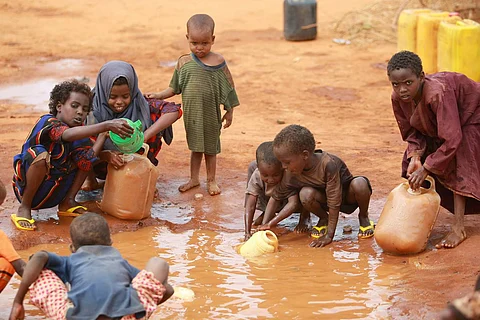

Sudan’s ongoing conflict has dismantled crucial infrastructure and food systems, plunging millions into a severe humanitarian crisis. With famine and failing health services widespread, more than 11.5 million internally displaced people are affected, while an additional 3.2 million seek refuge in neighboring countries.
Disruptions to food production and limited humanitarian access have put countless lives at risk. The United Nations is calling for urgent international intervention to mitigate further devastation as of January 2025.
Meanwhile, in Ukraine’s Donetsk region, the city of Pokrovsk is enduring a fierce siege. Recent flooding has worsened the situation, disconnecting power and water supplies, and prompting concerns about environmental damage.
As winter approaches, residents are scrambling to survive. Russian forces have seized strategic locations, including Kurakhove and Dachenske, escalating the humanitarian disaster.
The constant bombardment has left 70 per cent of homes and 95 per cent of industrial facilities destroyed, according to Brian Mann’s January 2025 report on Russia’s siege of Pokrovsk.
The overlapping impact of conflict and climate change is stark. The Global Climate Risk Index 2024 reveals that over 60 per cent of the most climate-vulnerable nations are simultaneously grappling with war. This convergence of crises exacerbates environmental damage, creating a vicious cycle of instability that demands immediate global attention.
In Sudan, the ongoing conflict between the Sudanese Armed Forces (SAF) and the Rapid Support Force (RSF) has disrupted state control and destabilised the security sector, as outlined by Susan Stigant in April 2023.
The environmental backdrop is equally dire, with rising temperatures and deteriorating land conditions threatening 46 per cent of Sudan’s territory. Resource competition is escalating, particularly in South Kordofan, where droughts have worsened food insecurity and access to clean water.
Despite efforts from organisations like the International Committee of the Red Cross (ICRC) to restore water services for over 400,000 people and distribute food to 56,000 in Kassala, logistical hurdles remain. Fuel shortages, infrastructure damage, and challenges in serving isolated areas continue to impede progress, as reported by the ICRC in December 2024.
The worsening desertification has also led to a 46 per cent drop in agricultural yields, according to the FAO’s March 2023-April 2024 report, compounding the humanitarian disaster. Sudan's crisis exemplifies how environmental strain can escalate existing conflicts and deepen human suffering.
The war in Ukraine has compounded the country’s vulnerability to climate change, with extreme weather events like floods and record heatwaves becoming more frequent.
According to the European Environmental Agency (EEA), Ukraine saw a 1.2°C temperature rise above pre-industrial levels in 2024, contributing to droughts and diminished crop yields in the east, as noted by the European Union’s science hub.
In Donetsk and Luhansk, floods have ravaged homes, forcing communities to rebuild amidst the ongoing conflict.
With winter on the horizon, the ICRC has launched a winter aid program to provide shelter and heating for 28,200 people. However, the reconstruction of essential infrastructure, including energy and water systems, is moving slowly due to logistical challenges.
The Stockholm International Peace Research Institute (SIPRI) highlighted in a 2024 report that forced migration, driven by both environmental and political factors, has become a significant transnational issue. This trend is placing increasing pressure on neighboring countries to accommodate displaced populations.
The crises in Sudan and Ukraine emphasise the urgent need for a comprehensive, climate-resilient approach to humanitarian relief. In Sudan, the UNDP launched a $10 million initiative in November 2024 to improve food security and access to clean water for two million people.
The programme aims to build solar-powered water stations and repair irrigation systems, fostering agricultural productivity while promoting peace by reducing resource-based conflicts.
In Ukraine, the European Bank for Reconstruction and Development (EBRD) introduced a renewable energy program in June 2024, partnering with GOLDBECK SOLAR to develop solar photovoltaic projects generating up to 500 Megawatts (MWp). In December 2024, the EBRD provided $180 million in loans to support small-scale power generation.
However, as the International Institute for Environment and Development (IIED) pointed out in April 2024, around $100 billion annually is needed to address climate change in conflict-affected regions. Without coordinated funding and political will, scaling these efforts will remain a significant challenge.
A session at COP29, titled “Fragile Futures: Finance, Climate and Conflict — Supporting Resilience in Vulnerable Communities,” underscored the need for more targeted climate finance in conflict zones. Experts criticised the mismatch between traditional climate finance models and the unique needs of war-torn regions. While promises were made to triple climate finance to $300 billion annually by 2035, the distribution of funds remains slow and uneven, as reported by Down To Earth in November 2024.
With conflict-affected nations like Sudan and Ukraine receiving less than $1 per capita in climate adaptation funding, transparency and equitable fund distribution by developed countries are crucial to building resilience and ensuring sustainable development in these vulnerable regions.